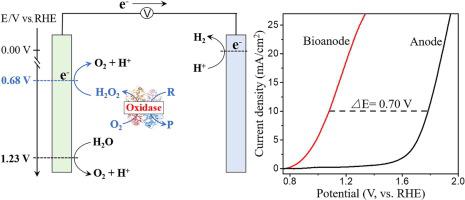Science Bulletin ( IF 18.9 ) Pub Date : 2020-08-06 , DOI: 10.1016/j.scib.2020.08.010 Jun Zhang 1 , Xia Sheng 1 , Zhenyao Ding 1 , Haili Wang 1 , Lai Feng 2 , Xiqi Zhang 3 , Liping Wen 3 , Lei Jiang 4 , Xinjian Feng 1

|
Water electrolysis to produce H2 is a promising strategy for generating a renewable fuel. However, the sluggish-kinetics and low value-added anodic oxygen evolution reaction (OER) restricts the overall energy conversion efficiency. Herein we report a strategy of boosting H2 production at low voltages by replacing OER with a bioelectrochemical cascade reaction at a triphase bioanode. In the presence of oxygen, oxidase enzymes can convert biomass into valuable products, and concurrently generate H2O2 that can be further electrooxidized at the bioanode. Benefiting from the efficient oxidase kinetics at an oxygen-rich triphase bioanode and the more favorable thermodynamics of H2O2 oxidation than that of OER, the cell voltage and energy consumption are reduced by ~0.70 V and ~36%, respectively, relative to regular water electrolysis. This leads to an efficient H2 production at the cathode and valuable product generation at the bioanode. Integration of a bioelectrochemical cascade into the water splitting process provides an energy-efficient and promising pathway for achieving a renewable fuel.
中文翻译:

通过整合三相界面生物电化学级联反应将制氢与水氧化分离
电解水生产 H 2是一种很有前途的可再生燃料生产策略。然而,缓慢的动力学和低附加值的阳极析氧反应(OER)限制了整体能量转换效率。在此,我们报告了一种通过在三相生物阳极用生物电化学级联反应代替 OER来提高低压下 H 2产量的策略。在氧气存在的情况下,氧化酶可以将生物质转化为有价值的产品,同时生成可以在生物阳极进一步电氧化的H 2 O 2 。受益于富氧三相生物阳极的高效氧化酶动力学和更有利的 H 2 O 2热力学与 OER 相比,相对于常规水电解,电池电压和能耗分别降低了约 0.70 V 和约 36%。这导致在阴极产生高效的 H 2并在生物阳极产生有价值的产物。将生物电化学级联集成到水分解过程中为实现可再生燃料提供了一种节能且有前途的途径。



























 京公网安备 11010802027423号
京公网安备 11010802027423号